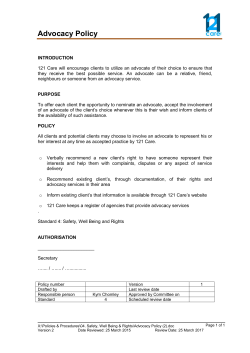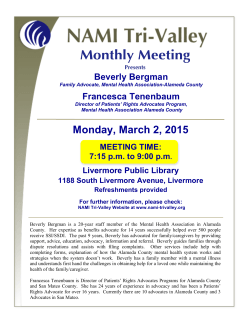
Competencies document - Health / Patient Advocate Credential
DRAFT ‐ For Review and Comment Only (through July 10, 2115) Patient Advocate Certification Board (proposed) Competencies for Certification for a Board Certified Patient Advocate (BCPA) The Domains of Patient Advocacy 1. 2. 3. 4. 5. 6. Scope of Practice and Transparency Empowerment, Autonomy, Rights, and Equity Professionalism and Professional Development Communication and Interpersonal Relationships Health Care Access, Financing, and Management Medical Knowledge and Health Care Operations 1. Scope of Practice and Transparency Patient Advocates will: a. Provide clear, accurate, and complete information about training, education, experience, credentials, and limitations, as well as any possible fees and areas of potential conflict of interest; b. Inform clients about the limits of their scope of practice and advise clients strictly within their defined area of proficiency; c. Develop clear and achievable expectations with the client to encourage a strong working relationship and productive advocacy; d. Notify the client immediately and proceed only with the written agreement whenever a potential financial benefit may accrue from referral to a service or product; e. Abide by all relevant laws and regulations related to confidentiality of medical and identity information; f. Avoid making any decision for, or on behalf of, a client; g. Avoid diagnosing or prescribing any medical/mental health treatment for clients, even if the advocate has additional licensure or training; h. Refer clients to qualified alternate providers in the event that a client’s needs are outside the scope of the advocate’s knowledge or training. 1 DRAFT ‐ For Review and Comment Only (through July 10, 2115) 2. Empowerment, Autonomy, Rights, and Equity Patient Advocates will: a. Treat clients fairly regardless of age, race, spirituality, culture, ethnicity, sexual orientation or gender identity, economic status, or ability; b. Promote equitable access to appropriate healthcare and treatment; c. Offer continuous client‐centered services that represent the best interests of the client, as determined by that client (or a legal health care proxy); d. Foster self‐determination and client engagement, treating the client with respect and compassion in all interactions; e. Respect the dignity and freedom of clients to make their own decisions grounded in their cultural, spiritual, and ethical context; f. Provide clients with information and resources to facilitate informed decision‐making regarding care and treatment, including palliative and end‐of‐life care; g. Assist clients in understanding care and treatment options, including potential risks, benefits, and available alternatives; h. Apply the principles of bioethics and the national standards for Culturally and Linguistically Appropriate Services (CLAS), and work to protect clients’ rights and choices; i. Convey relevant medical history, statutory patients’ rights, and possible care options to any legally designated surrogate, as requested by the client, including personal conversations in which the client may have expressed certain wishes that might guide informed decisions; j. Encourage clients to complete necessary documentation as appropriate (e.g., Durable Power of Attorney for Healthcare, Durable Power of Attorney for Financial Affairs, Advanced Directives). 2 DRAFT ‐ For Review and Comment Only (through July 10, 2115) 3. Professionalism and Professional Development Patient Advocates will: a. Assess the client relationship on a regular basis and facilitate the ongoing development, recognition, and maintenance of professional boundaries, and the avoidance of situations in which those boundaries are at risk; b. Continue to develop skills and maintain competence in their specific areas of expertise; c. Work within the scope of their credential and obtain continuing education credits as dictated by professional regulatory/credentialing bodies; d. Keep abreast of laws, policy, research developments, and trends that affect the practice of patient advocacy; e. Take initiative to seek out colleagues, mentors, and other experts regarding challenging client situations. 3 DRAFT ‐ For Review and Comment Only (through July 10, 2115) 4. Communication and Interpersonal Relationships Patient Advocates will: a. Provide empathetic, non‐judgmental, supportive listening and interactions that emphasize self‐ determination, well‐being, resilience, and an assets‐based approach; b. Collaborate effectively with other members of the health care team to ensure appropriate and compassionate care for the client; c. Utilize conflict management skills in interactions between the client and family, health professionals, or other relevant stakeholders; d. Engage the family and caregivers in the development of any intervention and treatment plan as approved by the client; e. Integrate cultural, gender‐based, and religious/spiritual perspectives that may influence the client’s experience of illness, pain management, treatment, and health; f. Provide any written communication and documentation requested by the client in a timely, appropriate, and professional manner; g. Incorporate into communications the complex interplay of biological, psychological, and social factors that enhance the client’s functioning and well‐being; h. Advocate to alleviate suffering, promote health, and encourage well‐being whenever and wherever possible; i. Utilize appropriate style/approach to meet the client’s cognitive, literacy, and personality characteristics. 4 DRAFT ‐ For Review and Comment Only (through July 10, 2115) 5. Health Care Access, Financing, and Management Patient Advocates will: a. Comprehend and communicate to the client basic differences in public and private health insurance programs and maintain familiarity with state‐by‐state variations, as needed; b. Assist clients in evaluating their health insurance coverage to identify any omissions, impediments, and/or shortfalls; c. Remain current on key health care insurance reforms and marketplace features related to subsidies and tax credits, metrics of insurance plans, potential penalties, and insurance providers; d. Comprehend and apply the fundamentals of prescription drug costs and coverage for all clients; e. Gain fluency in medical bill interpretation and apply the general provisions of insurance coverage to each client’s situation; f. Develop understanding of the structural and contractual systems that impede access to care and programs available to the uninsured, while remaining mindful of the advocate’s role in systems transformation; g. Understand the sources of legal protection and utilize grievance, appeals, and complaints processes; h. Understand and be able to communicate how the healthcare system functions, and the roles, responsibilities, barriers, and constraints of patients, payers, and providers within the system; i. Offer information and empathy to clients experiencing the financial, emotional, and/or physical impact of medical debt; j. Clarify care transitions and assist clients in all aspects of these changes; k. Facilitate the client’s navigation through the complexities of the health care system continuum; l. Integrate community‐based resources to support and sustain the client’s well‐being; m. Identify barriers to care coordination and suggest methods to overcome them; n. Utilize the referral process to effectively provide the best coordinated care to the client. 5 DRAFT ‐ For Review and Comment Only (through July 10, 2115) 6. Medical Knowledge and Health Care Operations Patient Advocates will: a. Maintain familiarity with basic medical terminology, major life‐threatening illnesses and chronic diseases, and conduct research to uncover detailed and reliable medical information relevant to each client; b. Explain the structure and functionality of health care facilities and provider groups to clients and expose resources available through each system; c. Access the full range of healthcare providers and care delivery models and enable second opinion options; d. Help clients to coordinate care among many clinicians, settings, and affiliated providers. ‐‐‐‐‐‐‐‐‐END ‐‐‐‐‐‐‐‐‐ 6
© Copyright 2025












